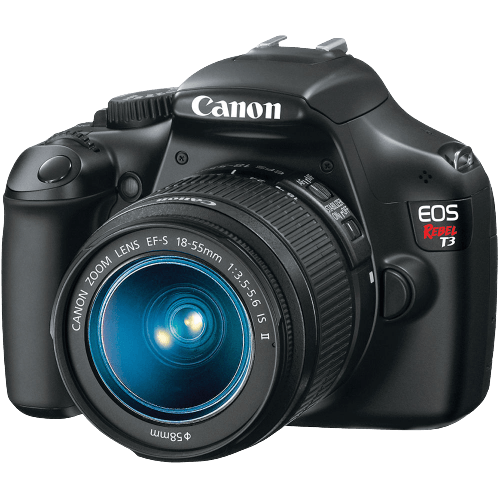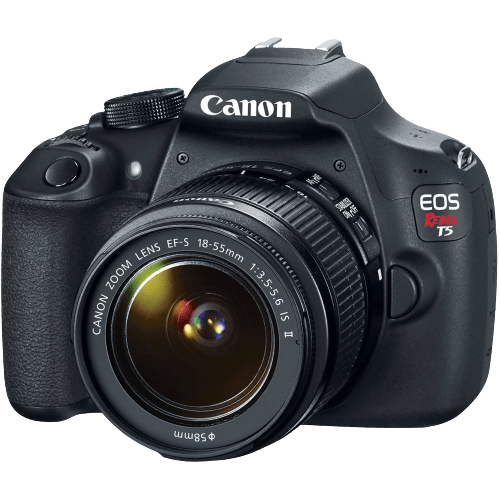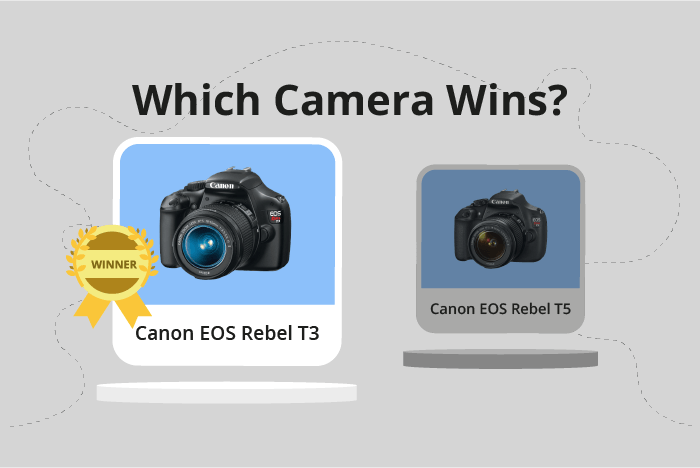Canon EOS Rebel T3 / 1100D vs EOS Rebel T5 / 1200D Comparison
Canon EOS Rebel T3 / 1100D

Canon EOS Rebel T5 / 1200D

The Canon EOS Rebel T3 / 1100D emerges as the winner with a score of 40/100, slightly ahead of the Canon EOS Rebel T5 / 1200D, which scores 38/100. Both cameras are DSLRs and share the same dimensions of 130 x 100 x 78mm. The Rebel T3 / 1100D, released in 2011, has a launch price of $599, while the Rebel T5 / 1200D, released in 2014, launched at $500.
The winning camera, the Rebel T3 / 1100D, has a higher score, indicating its better performance. However, the Rebel T5 / 1200D has a slight advantage in weight, being lighter at 480g / 1.06lbs compared to the T3 / 1100D’s 495g / 1.09lbs.
Despite the minimal difference in scores, the Rebel T3 / 1100D proves to be a better camera. On the other hand, the Rebel T5 / 1200D offers a more budget-friendly option and a lighter weight for those prioritizing affordability and portability.
Canon EOS Rebel T3 / 1100D vs EOS Rebel T5 / 1200D Overview and Optics
The Canon EOS Rebel T3 / 1100D wins the optics comparison with a score of 43/100, while the Canon EOS Rebel T5 / 1200D scores 39/100. Both cameras share some common specifications, such as a CMOS sensor, Digic 4 processor, APS-C sensor size, Canon EF-S lens mount, and no image stabilization. Their shooting speed is also the same at 3 frames per second.
The winning T3 / 1100D camera has a 12.2-megapixel resolution, which is less than the T5 / 1200D’s 18 megapixels. However, the T3 / 1100D’s DXOMARK score for the sensor is 62, one point lower than the T5 / 1200D’s score of 63. Despite the lower resolution, the T3 / 1100D offers better overall optics performance, as evidenced by the higher score.
On the other hand, the T5 / 1200D has a higher resolution of 18 megapixels, which could be an advantage for those who require larger prints or more detailed images. Nevertheless, this advantage does not outweigh the overall better performance of the T3 / 1100D in the optics department.
In conclusion, the Canon EOS Rebel T3 / 1100D is the better camera in terms of optics, despite its lower resolution. Its score of 43/100 outperforms the T5 / 1200D’s score of 39/100, and the common specifications between the two cameras do not provide any significant advantage for the T5 / 1200D. The T3 / 1100D’s superior optics performance makes it the preferred choice for photographers seeking better image quality.
Canon EOS Rebel T3 / 1100D vs EOS Rebel T5 / 1200D Video Performance
The Canon EOS Rebel T5 / 1200D outperforms the Canon EOS Rebel T3 / 1100D in video capabilities, scoring 43 out of 100 compared to the T3’s 34 points. Both cameras share some common video specifications. They both have a maximum video frame rate of 30fps and lack built-in time-lapse functionality.
The T5 / 1200D’s superiority is evident in its higher video resolution and dimensions. It offers Full HD video resolution, with maximum dimensions of 1920 x 1080, providing clearer and more detailed footage compared to the T3 / 1100D. The T3 / 1100D only offers Standard HD video resolution with maximum dimensions of 1280 x 720, resulting in lower quality video.
Despite the T3 / 1100D’s lower score, it does not surpass the T5 / 1200D in any specific video aspect. Its only advantage is in being an older model, which may result in a lower price point for budget-conscious buyers.
Evaluating the video capabilities of both cameras, the Canon EOS Rebel T5 / 1200D is the clear winner due to its superior video resolution and dimensions. This leads to higher quality video footage, making it a better choice for those seeking better video performance. The Canon EOS Rebel T3 / 1100D falls short in comparison, with its only potential benefit being a lower cost.
Canon EOS Rebel T3 / 1100D vs EOS Rebel T5 / 1200D Features and Benefits
The Canon EOS Rebel T5 / 1200D wins in the features category with a score of 36/100, while the Canon EOS Rebel T3 / 1100D scores 34/100. Both cameras share some common specifications, such as the lack of a touchscreen, GPS, WIFI, and bluetooth.
The winning camera, the T5 / 1200D, has a larger screen size of 3 inches compared to the T3 / 1100D’s 2.7 inches. Additionally, the T5 / 1200D’s screen resolution is higher at 460,000 dots, while the T3 / 1100D has a resolution of 230,000 dots. The T5 / 1200D also has a flip screen, which the T3 / 1100D lacks. These advantages make the T5 / 1200D a better choice for users who prioritize screen size, resolution, and flexibility.
The T3 / 1100D, despite having a lower feature score, is not without its merits. However, in this comparison, it does not have any specific advantages over the T5 / 1200D. Its lower score is due to its smaller screen size, lower screen resolution, and lack of a flip screen.
When comparing the features of these two cameras, the Canon EOS Rebel T5 / 1200D is the clear winner due to its larger screen size, higher screen resolution, and the presence of a flip screen. The T3 / 1100D, while still a capable camera, does not offer any advantages in this category. Buyers should consider their specific needs and preferences when choosing between these two models, but the T5 / 1200D stands out as the better option in terms of features.
Canon EOS Rebel T3 / 1100D vs EOS Rebel T5 / 1200D Storage and Battery
The Canon EOS Rebel T3 / 1100D wins in the storage and battery category with a score of 32/100, while the Canon EOS Rebel T5 / 1200D scores 27/100. Both cameras have one memory card slot and accept SD, SDHC, and SDXC memory cards. They also share the same battery type, the LP-E10, and neither offers USB charging.
The T3 / 1100D outperforms the T5 / 1200D in battery life, providing 700 shots per charge compared to the T5 / 1200D’s 500 shots. This makes the T3 / 1100D more suitable for extended shooting sessions without needing to replace or recharge the battery.
The T5 / 1200D does not have any advantages in storage and battery over the T3 / 1100D, making the T3 / 1100D the clear winner in this aspect. The longer battery life of the T3 / 1100D makes it a more reliable choice for photographers who need a dependable camera for longer shoots.
Alternatives to the Canon EOS Rebel T3 / 1100D and EOS Rebel T5 / 1200D
Are you still undecided about which camera is right for you? Have a look at these popular comparisons that feature the Canon EOS Rebel T3 / 1100D or the Canon EOS Rebel T5 / 1200D:

